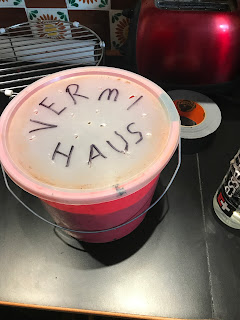Fall 2022 I bought a 5 dollar tub of red wigglers, saving them from being lizard food. They were alive but sluggish having been kept in a fridge for who knows how long. Census showed 47 live worms. I made them a home in a 2 gallon bucket. The bottom layer was 3" of shredded paper, 5 inches of good, light homemade compost, topped with wet newsprint. I added the worms and all their media, which has some castings in it.

Food was kitchen scraps. It was Halloween so lots of pumpkin innards (not seeds) for a while plus anything going bad in the fridge like the parsley here. The worms became active and then were very hungry. They were eating their own weight in food every other day. The best foods were already over-ripe and breaking down. Favorites were rotten fruit, and green leaves like spinach. They slowed down after a bit and I set a regular feeding schedule for 2x a week. I saved food in baggies if I had too much and put it in the freezer, the thawing process further broke it down. They also eventually ate all their newsprint! The surprise was worms crawling the walls of the bin - not to escape but to harvest the nice clear condensation water on the sides and top. I never had to add any water to the system. In fact I started shredding egg carton to stir into the mix to control dampness. I gently lofted the entire contents every time I fed them to keep it aerated. You want the home to be slightly damp but never wet. They also eventually ate their egg carton cardboard too.

Between feedings they lived in the water heater cabinet. Not hot there, but consistently warm in the high 70s. They seemed to like this temp.
At about 90 days I noticed juvenile members of the pod. Literature says that worms are hermaphroditic, but still need other worms to procreate. That is all I know about that.

This went on all winter. The bin slowly became more rich in castings. They do not seem to mid this as long as you add food and paper to absorb extra wet. I planned this as a seasonal activity, as gardening and composting slow down. Come spring my plan was to release them into the wild. I have a yard of largely sterile substrate, mostly sand.There are a few spots where there is more organic matter. I have one bed under a neglected mulberry tree than has been dropping leaves directly under itself with no apparent clean up to many years. There is actually near-soil there. On the first day of May I declared it to be worm rodeo and census day. I dumped their bin out on a large rubbermaid tub lid, and gently separated the worms from the casting using chopsticks. I counted. I had 258 red wigglers, and about 1 gallon of casting. The castings were put back into the Vermi Haus and mixed with water. I stared giving favored plants about a cup of this "tea" once a week. I kept adding water until mid June, when it was mostly depleted, but I put the left over solids on my native corn.

The worms were placed in a selected location under the Mulberry. I dug a deep hole, removed stones, and when I hit clean sand, I back filled with compost. Then I added the worms mixed with some of their casting and covered them with leaf mulch. I left one last meal, and cover and watered that.
Postscript: June 15, 2023 - I gently dug in. I found worms within 6 inches. They seemed healthy and vigorous, but do not seem to have dispersed much. I think I will dig a parallel hole a foot away and put a meal in there and see if they find it.
This was a fun experiment and trial in soil enrichment, and vermi care. I think I will repeat next winter.
.
I am happy to take questions in the comments section.









Comments
Post a Comment